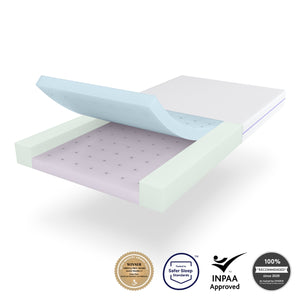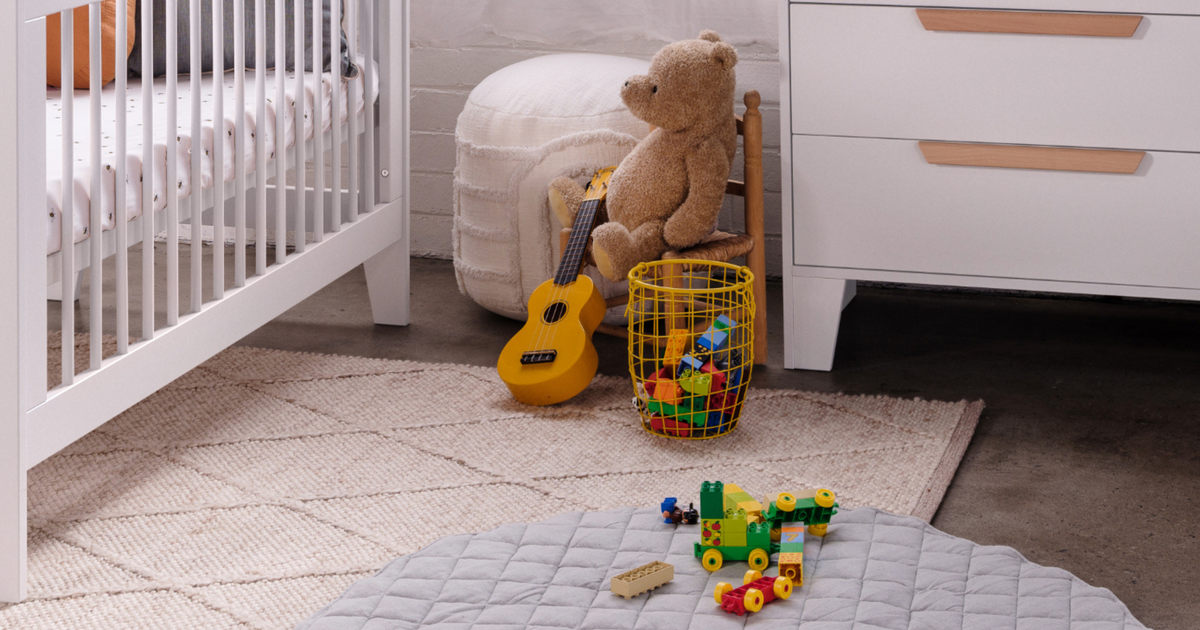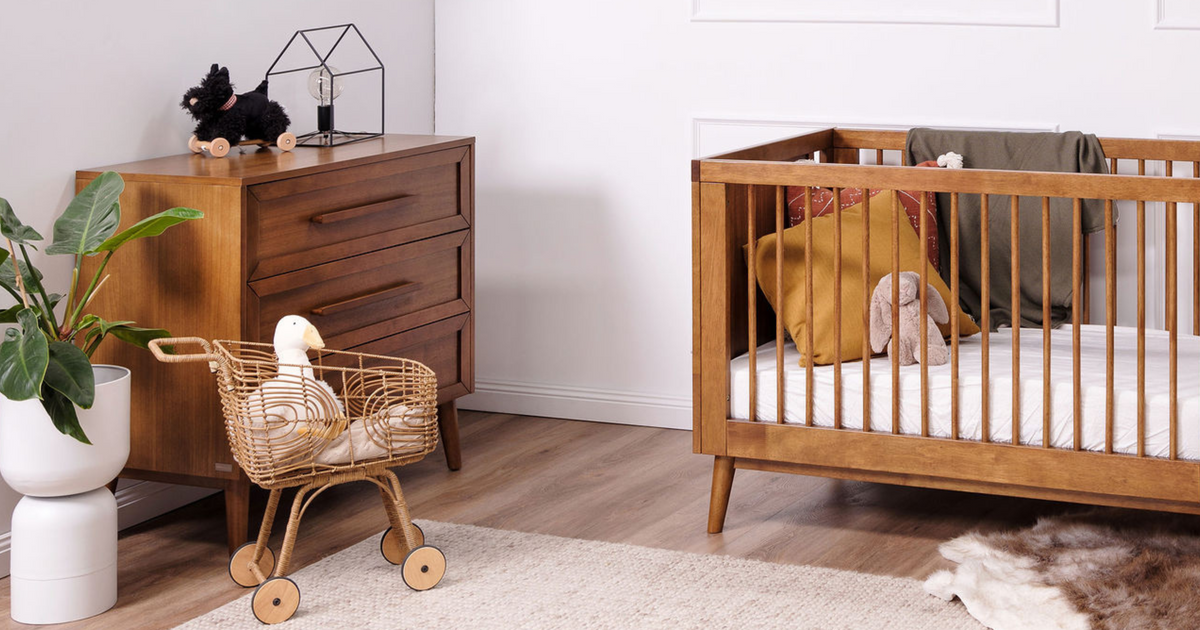What makes bamboo bedding so great for babies?

What comes to mind when you think ‘bamboo’? Chances are, it’s buttery soft loungewear or bedding. Afterall, bamboo fabric is naturally softer to the touch than cotton.
But did you know that this organic material is also naturally hypoallergenic, moisture-wicking and breathable? Not to mention a more sustainable option than many other fabrics such as cotton and polyester (if responsibly sourced and processed)?
It’s true! Now, considering the fact that infants generally spend around 12 to 16 hours a day sleeping, it makes sense to choose bedding that will be as gentle on their skin and as breathable as possible.
So, what makes bamboo different from other fabrics and why should you consider it for your baby? Join us as we walk you through the many benefits of bamboo to help you make an informed decision when it comes to your nursery’s bedding.
First things first, what is bamboo and how is it turned into fabric?
Bamboo has been cultivated for a variety of purposes from building materials to paper in Southeast Asia for thousands of years, however it has only been since the early 2000s that people have begun cultivating it for textiles such as bedding and clothing.
A type of grass, bamboo is extremely versatile and can be grown in a wide range of environments and climates, from rainforests to deserts. This versatility and sustainability offers great appeal, resulting in bamboo being farmed across the world, including in Australia.
Before it becomes your bedspread however, the bamboo plant needs to be harvested and dried in the sun for several days. From there, it undergoes a process of crushing, washing and bleaching to remove impurities and achieve uniform colour, before being woven into the fabric we all know and love.
Read Why rattan is an eco-conscious nursery choice →
Bamboo sounds great, but is it really the best for my baby?
As parents, we’ll do anything we can to ensure our little ones get a good night’s sleep. Choosing the right fabric for their bedding and clothing is one of the easiest ways we can do this.
A baby’s skin is particularly sensitive and prone to irritations, so choosing fabrics that are extremely soft and gentle to the touch can be a game-changer in their level of comfort, which can in turn help them to sleep for longer. Unlike regular cotton, bamboo fibres don’t contain any barbs or spurs, which can irritate sensitive skin. In fact, bamboo is so gentle on the skin, that parents of ‘butterfly children’ with epidermolysis bullosa (EB) use it in a bid to protect their children’s extremely fragile skin.
A natural fibre like bamboo is not only buttery soft, but also hypoallergenic, making it a great choice for babies prone to rashes, eczema, and allergies as it repels irritants like mould, mildew and even dust mites, while its natural antimicrobial properties help prevent odor. Although allergen-related issues often require complex solutions, choosing hypoallergenic bedding, mattresses and pillows can all contribute to a better sleep experience for both baby and parents.
You may have noticed a lot of athletic-wear being made from bamboo in recent years, so if you’ve ever seen a sweaty post-nap baby, choosing an absorbent material for their bedding and clothing makes a lot of sense! As it so happens, bamboo fibres are more moisture-wicking than cotton and can absorb up to 3x their weight in water. This means that choosing the right bedding can help your little one stay both cool and dry - even in the midst of a hot Australian summer day.
The benefits don’t end there however; bamboo fabrics are also breathable, which can help regulate your little one’s body temperature. Afterall, what’s the point of choosing a mattress for its great ventilation if you cover it with non-breathable sheets? Finally, bamboo fibres are extremely durable and remain strong even after repeated washing - the ultimate test for any nursery item!
 Image sourced from Unsplash
Image sourced from Unsplash
Bamboo offers your baby benefits beyond their current comfort however; it’s also an investment into their future.
In recent years, bamboo’s soaring popularity has seen farms pop up on every continent bar Antarctica.
Why?
Bamboo is a more sustainable fabric alternative to other materials, including cotton and polyester, for several reasons. The most significant being the fact that it is a rapidly renewable resource, able to grow up to 91 cm in a mere 24 hours, making it one of the fastest growing plants in the world!
This means that that same field would yield significantly more bamboo than it would cotton, over the same period of time. Less replanting in addition to the plant’s extensive root system also means that bamboo farming is associated with less soil erosion than many other crops and can be particularly useful along areas prone to mudslides and rain runoff. This is likely to become even more appealing to communities as climate concerns around the world grow.
With water being a finite resource, it’s important to note bamboo’s low water consumption compared to many other crops due to its roots’ excellent water retention. In fact, bamboo only requires one-third of the water required by cotton, and, unlike cotton, bamboo can also grow without the use of pesticides and fertilisers (although this is not always practiced by farmers).
Bamboo is also known for absorbing carbon dioxide (CO2). Able to sequester up to 12 tonnes of CO2 per hectare each year, you can sleep well knowing that your choice of baby bedding is actually helping to mitigate climate change if you choose bamboo. Isn’t it great knowing that each green choice that you make as a parent today (no matter how small) can help contribute to a better future for your little one?!
With all of this in mind, it comes as no surprise then that more and more people are seeing both the sustainability and economic viability of farming such a rapidly renewable resource in an age where climate change demands innovative new ways of doing things. The bamboo boom is only getting started.
In summary, when it comes to bamboo, you don’t have to choose between lush, buttery soft fabric and sustainability. So what are you waiting for?
Discover the Babyrest bamboo range
As people who are passionate about helping babies (and their parents!) get the best night’s sleep possible, we’re excited to share the Babyrest bamboo range, including fitted sheets, pillow cases, the DuoCore Bamboo Cot Mattress and the Junior Pillow - Ventilated + Bamboo.
Babyrest bamboo bedding is made from 100% natural fibres, harnessing bamboo’s natural health benefits, making it ultra-soft, ultra-breathable, anti-bacterial and hypoallergenic. They are also safety certified with Oeko-Tex® Standard 100 for that extra peace of mind. The mattresses and fitted sheets are available to suit most bassinet, cot and portacot sizes.
Discover the Babyrest bamboo range:
- Fitted Bamboo Sheets
- DuoCore Bamboo Cot Mattress
- Junior Pillow Cases
- Junior Pillow - Ventilated + Bamboo
Discover the Babyrest rattan range:

Anstel has a team of passionate expert representatives. Get in touch with us today with any questions you have about your nursery essentials.
Other nursery-related blogs:
- Why rattan is an eco-conscious nursery choice
- How this Aussie mum finally found the perfect cot mattress
- Why you can trust the ‘Australian Made’ logo
- “A must have!” Why parents love Babyrest wool underlays
- How safe is your nursery? Your 10-step safety checklist
Keep reading:






